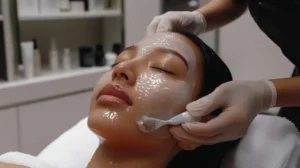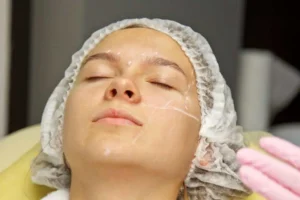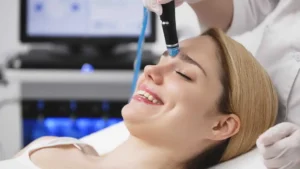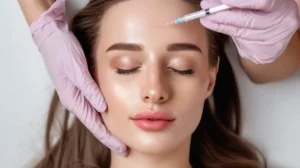Neurotoxins and dermal fillers are two types of anti-aging treatments that are effective against observable signs of aging, such as creases and fine lines. However, the nature of these treatments couldn’t be more different, and their methods of operation couldn’t be more distinct. It is critical to be conscious of the distinctions between neurotoxins and dermal fillers before deciding the type of remedy that will sufficiently serve your needs.
What Are Neurotoxins?
Neurotoxins like Botox are injected beneath the skin to relax the muscles responsible for forming wrinkles and fine lines. While Botox is the most widely used neurotoxin, other commercial products like Xeomin and Dysport also saw widespread use. A neurotoxin injection typically has a 3–4 month aftereffect. You won’t need to undergo surgical procedures because they are non-invasive.
How Do They Work?
Neurotoxins weaken the facial movements that result in fine lines and wrinkles by temporarily inhibiting the nerve cells that tell particular muscles to contract. You can still make facial expressions after these muscles weaken, but they are not as dramatic as before. Within a minute of injection, the toxin molecule starts to block the nerve-muscle connection, with results becoming apparent as early as seven days later. The full effects take 10–14 days to become evident.
As new nerves form connections to the muscles and start to regain activity after three to four months, neurotoxins will need to be administered again. Additionally, the product will gradually begin to be broken down by your body as it is naturally metabolized. Any lines and wrinkles that were previously present will reappear as the interaction with the muscle begins to return.
What Skin Concerns Do They Address?
Neurotoxins paralyze specific muscles, which fixes certain fine lines and wrinkles. Here are the following skin concerns they can address:
- horizontal lines
- crow’s feet
- the area between the eyebrows
As you can see, the majority of these creases are caused by the movement of your facial muscles, which is something you do every time you make a different kind of facial expression. These wrinkles are often identified as dynamic since they appear when you make a facial expression.
Injections of neurotoxins are a viable solution for addressing these concerns. But there is a catch: neurotoxins are ineffective against the wrinkles and fine lines that result from a loss of facial plumpness or sagging skin. These are what are commonly referred to as static wrinkles.
Neurotoxin injectables are not effective in the following areas:
- Jowl
- Cheeks
- Neck
In the fight against wrinkles, neurotoxins are only a temporary treatment, and our team cannot emphasize this point enough. Because of this, we strongly urge that you get another round of Botox injections every three to four months to maintain the results you’ve achieved.
What About Dermal Fillers?
On the other hand, dermal fillers are substances injected into the face that help restore the face’s volume and fullness. It is much simpler to tailor the product to a particular use because there is such a wide variety of choices regarding the degrees of volume and firmness it provides.
How Do They Work?
Dermal fillers work by supplementing the amount of hyaluronic acid that is produced by the skin.
As a result, dermal fillers revitalize the skin and add volume to it. This instantly reduces the appearance of lines and wrinkles and gives the face a more natural and softer appearance. Dermal fillers are soft, injectable gels composed of stabilized hyaluronic acid that is not derived from animals. The gel is kind to the body’s tissues and resembles the hyaluronic acid that occurs naturally in the human body. It has a lengthy lifespan but is not irreversible.
Dermal filler injectables offer a simple method for minimizing the look of wrinkles, improving the skin’s texture, and imparting an overall more youthful appearance. The result of a single treatment can be seen immediately, lasting anywhere from six months to nine months.
They can produce results that appear natural and do not alter a person’s ability to express emotion. Dermal fillers permit you to subtly retain your appearance as you age, despite the biological changes in your face over time.
What Do Dermal Fillers Address?
What exactly is it that dermal fillers are supposed to correct, though? To treat the undesirable effects of aging, you need several types of dermal fillers to address various concerns. Although the specific application will undoubtedly be determined by the type of filler that is selected, they can be used for anything from:
- Fix static wrinkles and fine lines
- Enhance thin skin, especially in shallow areas
- Reduce facial scars
- Enhance lips
- Remove or decrease undereye wrinkles or shadows
As mentioned, the wrinkles found near the mouth and cheeks are considered static. Why does something like this occur? Unsurprisingly, the absence of elasticity and collagen in your facial skin is the root cause of static wrinkles. The decreased production of these essential proteins that keep you young directly results from aging.
Differences Between Fillers And Botox
The muscle is temporarily immobile and prevented from contracting due to the neurotoxin’s action. This affects the skin that is directly above the affected muscle, and it lessens the appearance of wrinkles in the region that is being affected.
On the other hand, dermal fillers perform their function by augmenting the volume of the underlying area. Thanks to its volumizing effects, the skin is prevented from sagging and folding due to increased volume, and the appearance of fine lines and wrinkles is improved.
In short, Botox addresses dynamic wrinkles, wrinkles that move. In contrast, fillers address static wrinkles that appear whether you move your facial muscles or not.
How Do You Choose?
The characteristics of the patient, as well as the treatment area and the desired outcome, should always be considered when selecting the appropriate treatment.
Dermal fillers are, as a rule, the most popular option for cheek lifts, lip enhancements, and the treatment of very deep and long lines. Neurotoxins are typically the most effective treatment option when treating wrinkles on the face that result from movements, such as crow’s feet or laugh lines.
Takeaway
So if you are interested in considering either Botox or dermal fillers, contact and reach out to our clinic, ELLA Medical Aesthetics. Sally Santos and her professional team of aesthetician experts can help you address whatever cosmetic concerns you have through their services.








